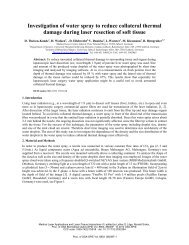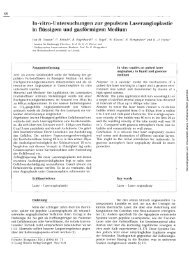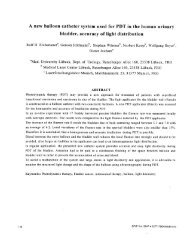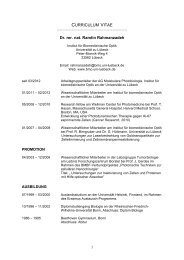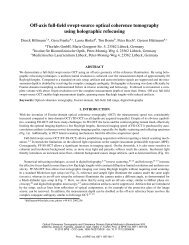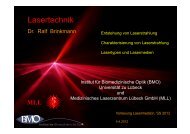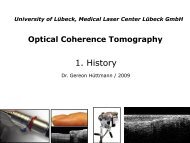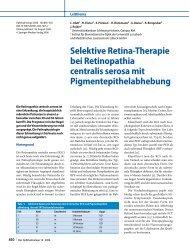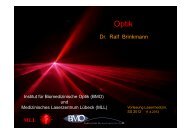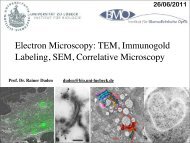Invited p aper Mechanisms of femtosecond laser nanosurgery of ...
Invited p aper Mechanisms of femtosecond laser nanosurgery of ...
Invited p aper Mechanisms of femtosecond laser nanosurgery of ...
You also want an ePaper? Increase the reach of your titles
YUMPU automatically turns print PDFs into web optimized ePapers that Google loves.
VOGEL et al. <strong>Mechanisms</strong> <strong>of</strong> <strong>femtosecond</strong> <strong>laser</strong> <strong>nanosurgery</strong> <strong>of</strong> cells and tissues 1033FIGURE 17 Stress-wave amplitude for 100-fs pulses and longer pulse durationsas a function <strong>of</strong> the dimensionless <strong>laser</strong> pulse energy E/E th .Thepressure amplitudes were measured by means <strong>of</strong> a hydrophone at 6-mmdistance from the <strong>laser</strong> focusat 6-mm distance is 0.12 MPa (Fig. 17). The resulting decayconstant is n = 1.13. Previous investigations <strong>of</strong> complete p(r)curves for spherical shock waves produced by 30-ps pulses <strong>of</strong>50-µJ energy yielded a very similar constant <strong>of</strong> n = 1.12 overa large range <strong>of</strong> propagation distances [96].An estimate <strong>of</strong> the pressure value at 6-mm distance producedby a 100-fs pulse with threshold energy was obtained byextrapolating the data for E/E th ≥ 1.5 in Fig. 17 to E = E th .It is about 0.008 MPa. The plasma radius at E th was identifiedwith the focal radius <strong>of</strong> 2.2 µm measured using a knife-edgetechnique [127]. A pressure <strong>of</strong> p = 0.008 MPa at 6-mm distancecorresponds to a pressure value <strong>of</strong> 61 MPa at the plasmarim when a decay constant n = 1.13 isassumed,andtoavalue<strong>of</strong> 56 MPa with a decay constant <strong>of</strong> n = 1.12, respectively.Our calculations <strong>of</strong> the thermoelastic stress generation predicta peak pressure <strong>of</strong> 168 MPa at the bubble-formation threshold(see Sect. 6.3, below). According to Fig. 14, the stress transientthat leaves the heated region in the radial direction hasa peak pressure <strong>of</strong> ≈ 25% <strong>of</strong> the maximum compressive amplitudewithin the focal volume. We thus obtain a theoreticalprediction <strong>of</strong> 42 MPa for the amplitude <strong>of</strong> the thermoelasticstress wave at the plasma rim. Considering the uncertainties inthe location <strong>of</strong> the plasma rim and the differences in numerical<strong>aper</strong>ture between experiment and calculation, the agreementbetween experimental results (56–61 MPa) and calculateddata (42 MPa) is very good.Both experiments and calculations reveal that stress confinementin <strong>femtosecond</strong> optical breakdown results in thegeneration <strong>of</strong> high pressure values even though the temperaturerise is only relatively small. In a purely thermal process,a temperature rise to, for example, 200 ◦ C starting fromroom temperature would produce a saturation vapor pressure<strong>of</strong> 1.6MPa. The compressive pressure transient produced bya temperature rise <strong>of</strong> 180 ◦ C under stress-confinement conditionshas an amplitude <strong>of</strong> 220 MPa, which is more than twoorders <strong>of</strong> magnitude larger than the vapor pressure.The situation is different for optical breakdown at longerpulse durations where the stress-confinement condition is notfulfilled. Here, high pressures are always associated with hightemperatures and plasma energy densities. For pulses whichare considerably longer than the thermalization time <strong>of</strong> thefree-electron energy, a dynamic equilibrium between generation<strong>of</strong> free electrons and thermalization <strong>of</strong> their energy is establishedduring the <strong>laser</strong> pulse [81]. This leads to a high value<strong>of</strong> the plasma energy density [80] and a temperature <strong>of</strong> severalthousand degrees Kelvin [175–177]. The duration <strong>of</strong> the resultingshock wave is determined by the time it takes for thehigh pressure within the plasma to decrease during the plasmaexpansion [96], which for NA = 0.9 was found to be about25–40 ns [3]. By contrast, the duration <strong>of</strong> the thermoelasticstress transients is determined by the geometric dimensions<strong>of</strong> the breakdown volume, which are in the sub-micrometerrange. This leads to a duration <strong>of</strong> the stress transients <strong>of</strong> theorder <strong>of</strong> or less than 300 ps (Fig. 15). The short duration <strong>of</strong>these stress waves is correlated with a small energy content(see also Sect. 6.4).6.3 Threshold for stress-induced bubble formationA specific feature <strong>of</strong> the stress transients generatedduring fs optical breakdown is their tensile componentthat is related to the high degree <strong>of</strong> stress confinement duringenergy deposition. The tensile stress makes it possiblethat a cavitation bubble can be generated by a relatively smalltemperature rise in the liquid. The threshold for bubble formationis defined by the temperature rise leading to a crossing<strong>of</strong> the kinetic spinodal, as shown in Fig. 13. For λ = 800 nm,NA = 1.3, and a room temperature <strong>of</strong> 20 ◦ C, the critical temperaturerise and the corresponding critical tensile stress are∆T = 131.5 ◦ C and p =−71.5MPa, respectively. The correspondingcompressive pressure is 168 MPa.The temperature rise <strong>of</strong> 131.5 ◦ C at the threshold for bubbleformation corresponds to an increase in energy density<strong>of</strong> 551 J cm −3 which, according to (18), is produced bya free-electron density <strong>of</strong> ϱ c = 0.236 × 10 21 cm −3 . This electrondensity is less than the breakdown criterion <strong>of</strong> ϱ cr =10 21 cm −3 assumed in our numerical calculations and in mostother theoretical studies <strong>of</strong> plasma formation. The discrepancybetween the threshold values relying on different breakdowncriteria needs to be kept in mind when comparing the results<strong>of</strong> experimental studies, where bubble formation servesas breakdown criterion, with those <strong>of</strong> numerical simulations.The fact that <strong>femtosecond</strong> optical breakdown is associatedwith only a relatively small temperature rise explainswhy plasma luminescence is no longer visible for pulse durationsshorter than about 10 ps [122, 128]. For pulse durationslonger than the thermalization time, large amounts <strong>of</strong> energyare transferred from the free electrons to the heavy particlesduring the <strong>laser</strong> pulse [81], resulting in a temperature <strong>of</strong> severalthousand degrees Kelvin, bubble formation, and a brightplasma luminescence [175–177]. By contrast, a peak temperature<strong>of</strong> 151.5 ◦ C reached at the threshold for bubble formationwith 100-fs pulses is too low to produce black-body radiationin the visible range <strong>of</strong> the optical spectrum. Moreover,the recombination radiation <strong>of</strong> <strong>femtosecond</strong>-<strong>laser</strong>-producedplasmas is weak because only one ‘set’ <strong>of</strong> free electrons is producedthat recombines after the end <strong>of</strong> the <strong>laser</strong> pulse. Theenergy density will remain small also at energies above thethreshold for bubble formation because <strong>of</strong> the shielding <strong>of</strong> thefocal region by plasma formation upstream <strong>of</strong> the focus [80,126, 136–139] (see Sect. 3.2). Therefore, bubble formation is



